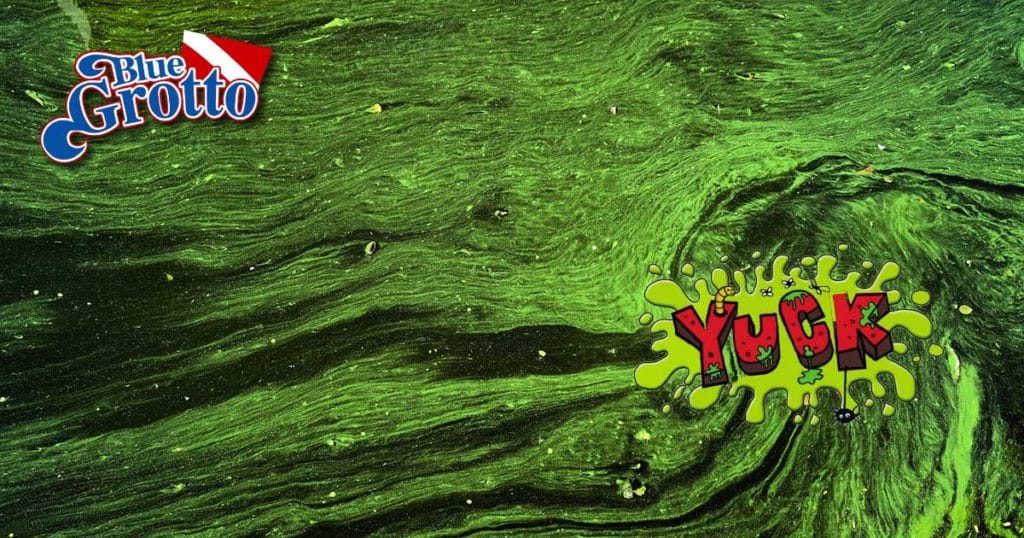The crystal-clear water you usually find in Blue Grotto is among the chief reasons divers come here. As you can imagine, we become rather anxious if anything adversely affects visibility. This happened recently, although, thankfully, we are over the worst of it.
Several factors can impact the visibility in Florida’s springs. These include sediment from rain runoff and tannin from rising river water. Fortunately, neither of these factors affects Blue Grotto. For us, the bogeyman comes in the form of an algae bloom.
An algae bloom is the rapid growth of photosynthetic organisms in fresh or salt water. There are many types of algae blooms. You can learn about these by following the link to a Wikipedia article you will find at the bottom of this page. This article will focus on the type of algae bloom that occasionally affects Blue Grotto.
It takes the right ingredients
For an algae bloom to form in Blue Grotto, three factors must be present. These are:
- Nutrients
- Heat
- Lack of water movement
Let’s look at each.
- Nutrients: Like any organism, algae must eat. Its food comes in the form of nitrates and phosphates. These are common components in fertilizer. The areas upstream of the Grotto are mainly agricultural. To maximize crop yield, farmers use tons of fertilizer. Rainfall causes these components to leach into the aquifer. So, even though you can’t see them, they are there.
- Heat: If the water remains at its normal 72° F, it inhibits algae growth. However, an increase of just a few degrees is all it takes for the algae to explode. What can cause this increase? It’s the thing Florida is famous for. That is sunlight. It’s why the cavern remains clear even though we may get an algae bloom in the open-water basin.
- Lack of water movement: If the water flows normally, it won’t remain in the open-water basin long enough for the sun to heat it. However, should the water stop flowing, an algae bloom will have time to form.
Thankfully infrequent
The good news is that the factors that lead to an algae bloom happen infrequently. You may remember that a few years ago, a long period of heavy rain caused water levels in the Grotto to rise substantially. When this happened, we were wading through knee-deep water on the large deck that is usually several feet above water.
At this point, water movement in the Grotto stopped. As the sun beat down, water temperatures rose. It did not take long before we experienced the Algae Bloom from Hell. Fortunately, this generally happens only once or twice a decade.
In August, the Grotto experienced something none of us had seen before. This was an algae bloom that occurred even though water levels were normal. Our best guess is that this resulted from a combination of August heat and a lack of water movement. Fortunately, it didn’t last.
Dealing with the problem
On those rare occasions when algae starts to form, we have several methods for dealing with it.
- For the past few weeks, you may have noticed the large mesh awning covering the open-water basin. This reduces the amount of sunlight hitting the water by 40 percent.
- Beneath the large deck is a 42-inch impeller that helps move water from the open-water basin to the cave that underlies the end of the parking area. This helps make up for lack of natural water movement.
- As we’ve mentioned in previous articles, the waterfalls you see on the far side of the Grotto aren’t merely decorative. They move colder water from the cavern to the open-water basin, helping to cool things down.
These steps may not solve the problem, but they help.
Thank you, Mother Nature
We were beginning to worry that the August algae bloom might be something we’d have to live with for a while. Then, last week, we went down to the Grotto in the morning to discover that, to parphrase Forrest Gump, “And just like that, the Grotto was back to normal.”
Our guess is that a series of late-afternoon thunderstorms got the water moving again. Enough so that the water in the basin turned over overnight. That’s the good thing about algae blooms; they eventually go away. In this case, it happened sooner than expected.
Watching nature in action is one of the things we enjoy most about Blue Grotto. Even when it doesn’t cooperate, it provides a chance to learn.
September 12, 2022 update: We just learned about something else that can contribute to algae growth. Yet another intense rainstorm dumped several hundred pounds of clay into the open-water basin. Most of the clay settled out within a few days but not before it provided a rich source of nutrients for yet another algae bloom. As before, we are hoping the increase in groundwater flow will flush things out just as soon as possible.


